Abstract
This study aimed to analyze the characteristics of bicycle–passenger conflicts at bus stops and develop a model to predict the number of conflicts accurately. This paper investigated the traffic flow operation at bus stops by video recording. Duration and distribution characteristics of bicycle–passenger conflicts were statistically analyzed. Then four types of conflicts defined based on evasive behavior (cyclist yielding as Type 1, cyclist bypassing as Type 2, passenger yielding as Type 3, and passenger bypassing as Type 4) were compared. A generalized event count (GEC) model was established for bicycle–passenger conflict estimation and analysis. The main results indicated that: (1) The average conflict duration was 1.716 s, whilst 60.9% of conflicts existed near the accesses of bus stops in longitudinal direction; (2) Type 1 conflict was significantly different from Type 2, 3, and 4 conflicts in duration, whilst the three had no significant difference; (3) the proposed GEC model showed good performance in predicting bicycle–passenger conflicts, with 15.71% of mean-absolute-percentage-error and 0.8772 of R2; and (4) bicycle volume, bus passenger volume, and passenger crossing time were critical factors impacting the number of bicycle–passenger conflicts. Finally, transport agencies may consider installing separations and crosswalks to improve the safety of the stop area.
1. Introduction
In order to improve the sustainability and livability of urban environments, cycling and public transport, due to their low energy consumption and low pollution, have been strongly encouraged in metropolitan areas worldwide [1,2]. Electric bicycles and bicycle sharing systems are noticeably promoting the use of bicycles and have led to the recovery of this transportation mode. [3,4]. Meanwhile, governments and local authorities are taking many effective measures, like supplying efficient traveling services and promoting passenger comfort, to enhance the attraction of public transport and increase ridership further.
With the recovery of cycling and the increase of bus ridership, more interactions and mutual influences of the two modes occur in cities, especially in bus stop areas. In commuting intervals, high volumes of bicycle flow runs on city roads and buses are busy at bus stops. Bicycles and buses generally share the same lanes or paths in stop areas. In this case, bicycle flow is blocked by the buses accessing or egressing stops. Speed decrease, traffic collisions, and even jams present. To address this problem, cycle tracks or separated bicycle lanes are increasingly built in cities.
Although cycle tracks or protected bike lanes solve the conflicts between bicycles and buses, bicycles meet crossing passengers when they pass behind stops. In commuting intervals, when cycling and passenger flows are both at a heavy state, many conflicts occur, as shown in Figure 1. Due to the higher speed of bicycles, especially for electric bicycles, these conflicts most likely develop into crashes, causing injuries and even deaths. In the background of cycling speed-up, bicycle–passenger conflicts at bus stops create a safety issue that needs to be handled carefully.
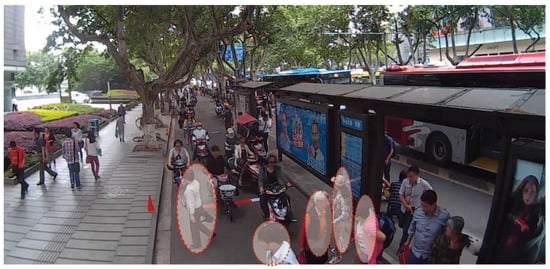
Figure 1.
Bicycle–passenger conflicts in commuting intervals.
Traffic conflicts are defined as an event involving two or more road users where one or both parties take evasive maneuvers to avoid a crash [5]. Hayward identifies the time-to-collision (TTC) as a major factor to describe the danger of a conflict situation [6]. Various other researchers have studied the severity and risk of conflict and identified that time-to-collision, and distance and speed of the approaching vehicle may contribute to severity or risk [7,8,9,10,11]. More recently, a comprehensive study from Casey et al. has developed conflict analysis performance measures for both pedestrians and bicyclists for both intersections and segments [12]. They considered two broad types of conflicts for both pedestrian and bicyclist interactions with the transportation infrastructure. A non-overtaking (or angled) conflict type occurs when parties (pedestrians, bicyclists, or vehicles) are not traveling in the same direction; and overtaking conflicts occurs between parties that are traveling in the same direction. The three factors considered in this study to measure the severity of conflict include speed of the approaching/crossing vehicle, lateral/longitudinal distance of the vehicle, and time to take action. In total, the study considers the following five types of conflicts: Pedestrian–vehicle, bicycle–vehicle, pedestrian-bicycle, vehicle–bicycle (overtaking), and bicycle–pedestrian.
Previously, more studies evaluating the influences of buses on motorized vehicles and cycling at stops were found. Koshy et al. compared the influence of the curbside stops and bus bays on the operations of motorized vehicles using a simulation model. Their result indicates that the quality of traffic stream, in terms of average speed, decreases rapidly beyond certain flow levels, in the case of curbside stops [13]. Zhao et al. applied a cellular automaton model in studying the traffic interactions between motorized and non-motorized vehicles near a bus stop. They found increasing stopped time of buses, or the ratio of buses would cause congestion easier in bicycle flow [14]. In the paper by Zhao et al., bus–bicycle interactions at different types of bus stops were evaluated and the results show that bicycle speeds are influenced significantly when a bicyclist meets a bus at a bus stop [15]. Zhang et al. investigated the influences of four types of bus stops on bicycles, vehicles, and buses. They noted that curbside stops created the least bicycle delay but the largest vehicle delay, whilst bus bays had the least impact on bicycle and vehicle operations, but occupied the most road space. [16]. Luo et al. used gap theory and queuing theory to model the effect of bus stops on the capacity of curb lane. They verified the high precision of the proposed potential capacity model by Vissim simulation [17]. Pan et al. implemented geographically weighted regression to explore the potential factors affecting the length of bus stop influence zones using multi-source data. They concluded that the number of enterprises and companies around bus stops, the distance between the stop and intersection, road hierarchy, the number of public facilities, the queue length of buses, as well as traffic volume had significant impact [18].
For conflict events, count models like Poisson and negative binomial models have been the most common methods adopted by scholars. For example, Nashad et al. developed a bivariate negative binomial model for pedestrian and bicycle crash frequency analysis [19]. However, Ye and Xu pointed out that the models could not usually be generalized to other data sets [20]. Later, Wang et al. proposed a generalized event model for bus–bicycle conflict estimation and analysis [21]. By comparing with a method-based queuing theory by Zhao et al. [15], their model obtained a better performance in predicting number of conflicts.
Literature review results display that the following three aspects have limitations or need to be addressed: (1) Most scholars have focused on the influences of bus stops on motorized vehicles and cycling, but few have studied the interactions between cycling and bus passengers. (2) Meanwhile, they have paid more attention to the negative effects of bus stops on the running efficiency of traffic flow rather than safety issues. (3) Several researchers have done some conflict studies at bus stops and have developed some generalized methods to model conflicts. However, the applicability of these methods remains to be verified in bicycle–passenger conflict analysis. Therefore, this study aims to achieve two objectives. The first is to analyze the characteristics of bicycle–passenger conflicts at bus stops. The second objective is to establish a generalized event model for the estimation of bicycle–passenger conflict. It can address the unknown dispersion of conflict data. The remaining sections of the paper are organized as follows. The section “Methods” describes the proposed methodologies to collect field data and predict the number of bicycle–passenger conflicts. The following section shows the results and discussions. The findings and conclusions are presented in the last section.
2. Methods
2.1. Data Collection
2.1.1. Field Survey
We captured traffic flow operations and bicycle–pedestrian conflicts on cycle tracks at bus stops using a dual-camera recording method during workdays in Nanjing. Field observations were performed in commuting intervals, from 07:00 to 09:00 for the morning peak and from 17:00 to 19:00 for the evening peak. The following are the selection criteria for the survey sites:
- (1)
- Differences in bicycle track width;
- (2)
- Paved level terrain, good sight;
- (3)
- Far from intersections and block accesses; and
- (4)
- Suitable space for installing cameras.
According to our preliminary observation, we chose 50 m as the length of a survey segment. The instruments used in our field work included a tape measure of 50 m, two wide-angle cameras, two tripods (maximum height of 4 m), 12 red traffic cones, and six marking tapes (dimensions: 30 × 150 cm and 120 cm of the center part colored in red).
The setting details for the observation are described in Figure 2. Subgraph (a) shows the installation of the whole investigated area, whilst subgraphs (b) and (c) indicate the field arrangements of surface markings and cameras respectively.
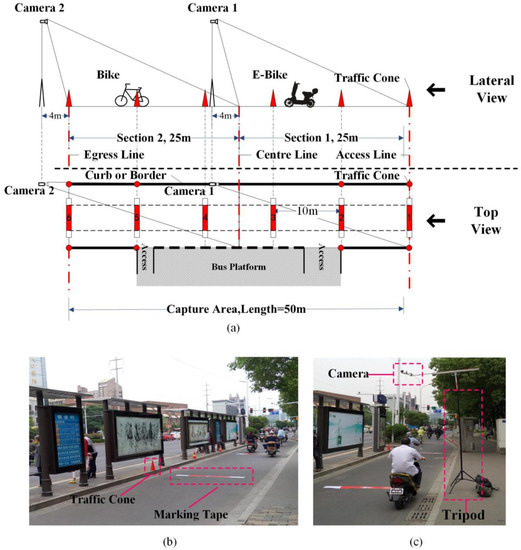
Figure 2.
(a) Setting details for field observation; (b) installation of traffic cones and marking tapes; and (c) setup of the camera and tripod in field.
2.1.2. Data Extraction
The research took 2 min as time unit to extract bicycle operation and conflict data from video. The operation data, including bicycle flow rate, passenger volume, and passenger crossing time, were obtained directly by reviewing the recorded videos and conducting some simple calculations (passenger crossing time).
For collision data, four types of bicycle–pedestrian conflicts were firstly defined according to the evasive behavior of the parties, as shown in Figure 3. In Type 1, a passenger reaches the intersection of the trajectories of the two sides earlier, the later bicycle chooses to brake to avoid a crash. Differently, in Type 2, the bicycle steers to the back of the pedestrian. When a bicycle arrives at the potential colliding spot earlier in Types 3 and 4, the pedestrian chooses to slow down and bypass the rear space of the bike, respectively.
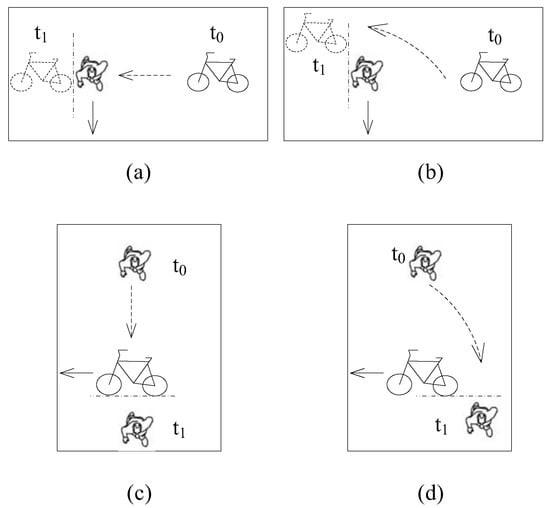
Figure 3.
(a) Type 1; (b) Type 2; (c) Type 3; and (d) Type 4.
After identifying the type of conflict, an observer recorded the position where the conflict happened, according to the path surface markings that divided the investigated area to 3 × 5 small parts, as illustrated in the top view of Figure 2a. The duration of a conflict was computed by calculating the difference of the start time (t0 in Figure 3) and ending time (t1). Number of conflicts was counted every 2 min to connect to the operation data.
2.1.3. Descriptive Analysis for Traffic Flows and Conflicts of Bus Stops
Table 1 shows the characteristics of traffic flow running on the tracks at the bus stops and the conflict counts. Overall, traffic flow at the surveyed bus stops varied within a large range. Bicycle volume changed between 30 bicycles and 1528.6 bicycles/h and pedestrian volume from 60 to 1860 (unit: Passengers/h). Passenger crossing time was defined as the duration when there were passengers crossing the cycle track at bus stops in a 2 min of count unit. According to the definition, the value of the parameter could not be larger than 120 s. The collected data of this parameter was from 5.5 to 120, nearly covering the theoretical range. Meanwhile, bicycle–pedestrian conflict data were distributed between 30 and 1650 counts. According to the description above, the data on traffic flows and collisions covered a wide range and prepared a solid basis for the conflict predicting modeling below.

Table 1.
Traffic flow characteristics and conflicts of bus stops.
2.2. Generalized Event Count Model (GEC)
In the GEC model, event counts represent the number of times a specified event happens within a fixed observation period (e.g., number of bicycle–pedestrian conflicts in this study). Because traffic collision counts are non-negative integers, the Poisson regression model is a commonly used method for conflict estimation. In many cases, however, due to the different degrees of dispersion of collision data, the Poisson regression model may not be a suitable method to predict the number of conflicts. Thus, a GEC model with parameters and was developed for > 0 and σ2 > 0. In this model, represents the mean and denotes the dispersion parameter. With the introduction of the parameter , the GEC model is capable of modeling event counts with unknown degrees of dispersion. When 0 < < 1, the GEC distribution can address under-dispersed data; when = 1, the model has the same probability function as the Poisson regression model; and when > 1, the data are over-dispersed, and its probability function is similar to the negative binomial (NB) regression model. The GEC’s probability distribution offers smooth transitions between these cases.
The Poisson regression aims at modeling a collision variable Y, which follows a Poisson distribution with a parameter [22]. The probability that the number of conflicts takes the value on the ith entity can be denoted as:
In the Poisson regression model, the mean can be presented as , where = vector of k explanatory variables and = 1 × k parameter vector that displays the effect of the explanatory variables on the dependent variable. In this study, X0 represents constant term, X1 = bicycle volume, X2 denotes passenger volume, and X3 = passenger crossing time. , β1, β2, and denote coefficients of these variables. To derive the GEC’s probability distribution, a theory from a bilinear recurrence relationship was introduced below:
where and are ancillary parameters. In this case, Equation (1) should be re-parameterized to make the relationship suitable for previous definitions. Statistical analysis [23] shows that the expected value and variance of a random variable that adheres to the relationship in Equation (2) are as follows:
Solving the above two equations:
Substituting Equation (4) into Equation (2), the GEC probability function can be expressed as:
In theoretical statistics, is one of the given conditions of probability, which indicates that the probability of all situations is 1. To obtain , using standard results on the convergence of an infinite series leads to the final expression for the probability function [24]:
For the estimation of the GEC’s probability distribution, a maximum log-likelihood estimator is introduced as the following equation:
This model produces estimations of and in a single step simultaneously without specifying if the crash data are over-dispersed, under-dispersed, or Poisson-dispersed. Because no additional parameters were introduced in the GEC distribution, this model actually reduced the chance for inconsistency with no need for additional assumptions.
3. Results and Discussions
3.1. Duration and Distribution Characteristics of Bicycle–Passenger Conflict
Duration and space distribution are the basic features of a traffic event. In this subsection, we explored the two types of characteristics of bicycle–passenger conflicts happening outside the investigated bus stops.
As shown in Figure 4, the samples of conflict durations were grouped with 1-s intervals. It was found that the distribution of conflict duration was in accordance with normal distribution. Thus, it seemed reasonable to calculate the average duration of a bicycle–passenger conflict using the property of normal distribution. For the data in Figure 4, the average duration was 1.716 s after excluding the outliers.
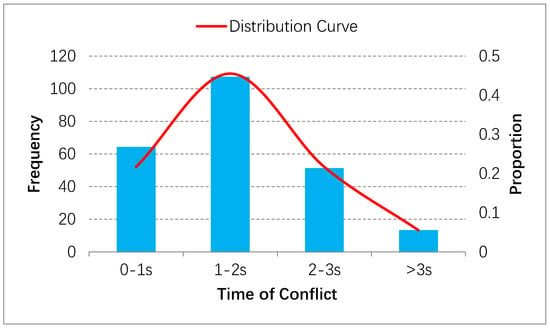
Figure 4.
Duration characteristics of bicycle–passenger conflicts.
Although the observed area was divided into 3 × 5 subparts, the accesses of a bus stop varied with the investigated sites. In order to obtain the common feature of conflict distribution, the 3 × 5 subparts were divided into those near accesses and far from accesses in longitudinal direction.
Figure 5 shows the results of distribution of bicycle–passenger conflicts. It presents that 60.9% of conflicts existed near the accesses of bus stops along the direction of bicycle flow, whilst 27.23% and 58.72% of conflicts occurred at the left and center parts of the cycle tracks, respectively. It should be noted that the left part of a cycle track is generally adjacent to a stop platform, as shown in Figure 2a. This means that 85.95% of conflicts distributed around the side of bus stops in lateral direction. In other words, more than 60% of bicycle–passenger conflicts happened near the back of bus stops or their accesses, rather than on the other side adjacent to footpaths. This is because the stop side has many amenities which disrupt both cyclists’ and passengers’ vision. Besides, fewer zebra crossings attracting cyclists’ attentions were marked around the accesses of bus stops in China. Therefore, to improve the track safety of bus stop area, some stop layouts that contribute better vision should be considered in future, and crosswalks needs to be listed as a necessary part when a cycle track is routed outside a bus stop.
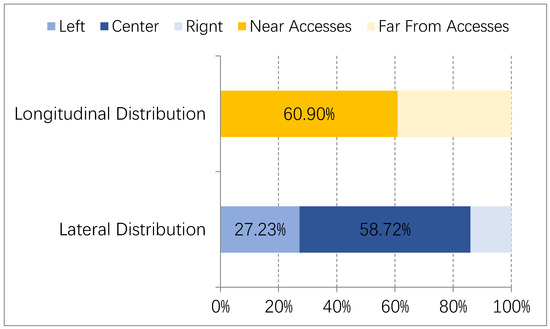
Figure 5.
Distribution characteristics of bicycle–passenger conflicts.
3.2. Comparative Analysis for Four Types of Bicycle–Passenger Conflicts
In Figure 3, we defined four types of bicycle passenger conflicts. This subsection will analyze the statistical features of durations of these conflicts (see Table 2) and then further compare their differences.

Table 2.
Duration characteristics of four types of bicycle–passenger conflicts.
Type 1 occurred most often out of all four types, with a value of 48.06%. This resulted from the priority of passengers’ right of way and more cyclists chose to brake to avoid an accident. Type 4 followed with 21.26%. Passengers had a smaller size, better mobility and flexibility on a narrow track in contrast to bicycles. So more passengers bypassed to the rear side of a bicycle in a conflict. Type 2 and 3 consisted of the same proportion (15.34%).
In duration, the four types of conflicts were all close to 0.400 s at the minimum. However, Type 1 was noticeably bigger than the other three in maximum, mean, median, and standard deviation (SD). It seems that the latter three were similar in the statistics mentioned above, whilst Type 1 was significantly different from them.
In order to confirm the difference among the four types of conflicts in duration, one-way analysis of variance test and multiple comparison analysis were performed, as shown in Table 3 and Figure 6. The multi-comparison result indicates the significance of Type 1 conflict with a clearly different 95% confidence interval. The overlapping of the other three in this interval proves that they were not significantly different in duration.

Table 3.
One-way analysis of variance test result of the differences in durations of four types of conflicts.
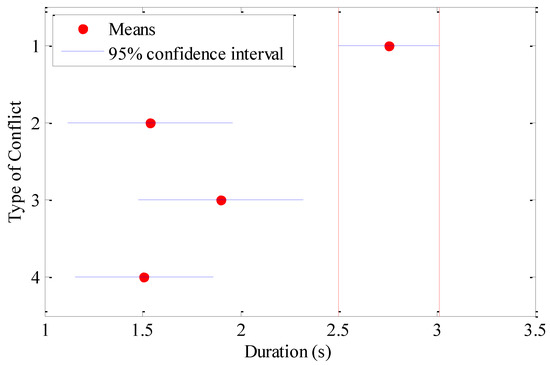
Figure 6.
Multi-comparison result for durations of the four types of conflicts.
3.3. Bicycle–Passanger Conflict Estimation
Based on the data collected for the bicycle volume, passenger volume, passenger crossing time, and the number of conflicts, as summarized in Table 1, the GEC model was used for the data set from bus stops. The modeled results (see Table 4) show that σ2 was 1.125, which shows that the data set was over-dispersed. The coefficients of constant term, bicycle volume, passenger volume, and passenger crossing time were −3.652, 0.589, 0.528, and 3.143, respectively. The p-values from the model indicate that all the above-factors were significant variables influencing the number of conflicts between bicycles and transit passengers.

Table 4.
Results for the GEC Model.
The mean absolute percentage error (MAPE) was applied to evaluate the performances of the GEC model. MAPE had no requirement for sample size and displayed an obvious advantage in evaluating discrete data [25]. The value of MAPE in this study was computed with the following equation:
To better evaluate the performances of the GEC model, the values of MAPE and linear regression analysis between estimated and observed counts of conflicts were charted, as indicated in Figure 7. In Figure 7, the slope of the line was 1.079, close to one. Scattered data points were balanced on both sides of the lines of identity, which showed that the proposed model was not undervalued or overvalued. MAPE and R2 for the proposed method were computed to be 15.71% and 0.8772, respectively, which indicates that the proposed method could estimate the number of conflicts between bicycles and crossing passengers at bus stops relatively accurately.
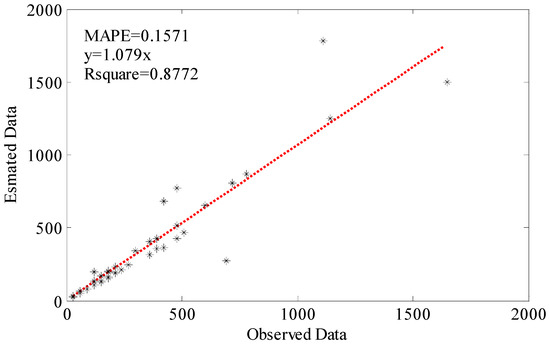
Figure 7.
Fitting relationships of number of conflicts between estimated and observed data.
The results of the GEC model display that bicycle volume, bus passenger volume, and passenger crossing time were critical factors impacting the number of bicycle–passenger conflicts at stops. There existed a positive relationship between number of conflicts and these factors. Among the three factors, bicycle and passenger volume are influenced by the trip characteristics of a city like traveling interval and conditions, and circumstances upstream of a bus stop (e.g., intersection setting). In contrast to the two factors above, passenger crossing time is more affected by the physical layout surrounding a bus stop, including track width, platform layout, and street amenities. Therefore, passenger crossing time is the most easily controlled affecting factor of all. Some simple measures like installing separations between a footpath and a cycle track and setting a crosswalk at the access of a bus stop can regulate the crossing behavior of bus passengers and decrease passenger crossing time effectively.
Wang et al. [21] and Zhao et al. [15] both performed similar studies on bus–bicycle conflict. According to their results, the common critical factors impacting the number of bus–bicycle conflicts were bus arrival rate, bicycle arrival rate, and bus average service time. Meanwhile, the significant factors in this study were bicycle volume, passenger volume, and passenger crossing time. By comparing these factors in bus–bicycle and bicycle–passenger conflicts, we could obtain some generalized elements in the two types of conflicts. Bicycle volume (or arrival rate) and passenger volume (or bus arrival rate) were indicators that represented the generations or origins of the two parties in a conflict. Passenger crossing time or bus service time was a measurement of the duration that the conflict area was occupied by one party. Therefore, it provides a clear and useful reference or direction for researchers to conduct the other conflict studies in selecting indicators, no matter which model they adopt.
Although 15.71% of MAPE showed good performance of the proposed model, there exists some space to improve further. Research by David et al. showed that the cyclist–pedestrian conflict rate increased with pedestrian density [26]. However, they pointed out that the relationship was almost entirely a result of low-speed conflicts. Low-, moderate-, and high-speed conflicts were defined according to the speed of cyclist (the corresponding values were less than 10 km/h, between 10 and 15 km/h, and greater than 15 km/h). The rate of low-speed conflicts increased as a higher order polynomial as pedestrian density increased, whereas the rate involving moderate- and high-speed bicycles remained relatively stable. Based on the aforementioned study, the bicycle–passenger conflict in our study could be divided by cyclist speed in the future. Certainly, the dividing threshold needs to be reset because of the noticeably different characteristics of cyclist speed in China. Then, a finer and more accurate GEC model could be established.
4. Conclusions
This paper investigated the traffic flow operation and bicycle–passenger conflicts of tracks at bus stops by video recording. Duration and distribution characteristics of bicycle–passenger conflicts were statistically analyzed. Then, four types of conflicts defined based on evasive behavior were compared. After that, a generalized event count model was established for bicycle–passenger conflict estimation and analysis. Finally, based on the study results, some suggestions were put forward for improving the safety of cycle tracks at but stop areas. The main results and conclusions are as follows:
- The distribution of conflict duration was in accordance with normal distribution and the average duration was 1.716 s 60.9% of conflicts existed near the accesses of bus stops in longitudinal direction, whilst 27.23% and 58.72% of conflicts occurred at the left and center parts of cycle tracks, respectively.
- Type 1 conflict was significantly different from the other three types of conflicts in duration, whilst there was no significant difference among Type 2, 3, and 4.
- The proposed GEC model showed good performance in predicting bicycle–passenger conflicts, with 15.71% of MAPE and 0.8772 of R2.
- The results of the GEC model show that bicycle volume, bus passenger volume, and passenger crossing time were critical factors impacting the number of bicycle–passenger conflicts at stops in these factors, passenger crossing time is most easily controlled and transportation agencies could implement countermeasures, like installing separations and setting a crosswalk, to improve the safety at bus stops.
As more cycle tracks are being built outside bus stops in cities, the conflicts between bicycles and bus passengers entering and exiting stops will occur more frequently. The characteristics of the conflicts need to be well understood and the factors affecting the number of conflicts should be taken into consideration in order to propose countermeasures for authorities. This study analyzed the most common factors affecting bicycle–passenger conflicts with the GEC model. Meanwhile, the performance of the proposed model was good. However, the cases and traveling conditions in different countries have diversity. Transport agencies need to investigate the local data to calibrate the model to obtain the best predicting performance. With the proposed investigation method, the traffic operations outside a bus stop can be effectively observed and it is feasible to extract the operation and conflict data using AI technology in trajectory capturing and event detecting. Thus, we suggest that transport agencies may consider installing cameras at the back of a stop as a normal configuration for regular management and academic purposes.
Author Contributions
Z.Y. undertook the data collection. X.Y. (Xingchen Yan) provided an interpretation of the results and wrote the majority of the paper. T.W. and H.B. contributed to the paper review and editing. X.Y. (Xiaofei Ye) performed the software work of the paper. J.C. was the supervisor of the paper.
Funding
This research was funded by the National Key Research and Development Program of China (grant No. 2018YFC0704704), the Fund for Less Developed Regions of the National Natural Science Foundation of China (grant No. 71861006), the Basic Research Program of Science and Technology Commission Foundation of Jiangsu Province (grant No. BK20180775 & BK20170932), the Key Project of National Natural Science Foundation of China (grant No. 51638004), the National Natural Science Foundation of China (grant No. 51408322), and Guangxi natural science fund (2016GXNSFAA380056).
Acknowledgments
The authors would like to express their sincere thanks to the anonymous reviewers for their constructive comments on an earlier version of this manuscript.
Conflicts of Interest
The authors declare no conflicts of interest.
References
- Moreno Gonzalez, E.; Romana, M.G.; Martinez Alvaro, O. Bus Dwell-Time Model of Main Urban Route Stops Case Study in Madrid, Spain. Transp. Res. Rec. 2012, 2274, 126–134. [Google Scholar] [CrossRef]
- Bordagaray, M.; dell’Olio, L.; Ibeas, A.; Cecin, P. Modelling user perception of bus transit quality considering user and service heterogeneity. Transp. A Transp. Sci. 2014, 10, 705–721. [Google Scholar] [CrossRef]
- Cherry, C.; Cervero, R. Use characteristics and mode choice behavior of electric bike users in China. Transp. Policy 2007, 14, 247–257. [Google Scholar] [CrossRef]
- Fishman, E.; Cherry, C. E-bikes in the Mainstream: Reviewing a Decade of Research. Transp. Rev. 2015, 36, 72–91. [Google Scholar] [CrossRef]
- Fan, R.; Yu, H.; Liu, P.; Wang, W. Using VISSIM simulation model and Surrogate Safety Assessment Model for estimating field measured traffic conflicts at freeway merge areas. IET Intell. Transp. Syst. 2013, 7, 68–77. [Google Scholar] [CrossRef]
- Hayward, J.C. Near-miss determination through use of a scale of danger. Highw. Res. Rec. 1972, 384, 24–34. [Google Scholar]
- Cynecki, M.J. Development of Conflicts Analysis Technique for Pedestrian Crossings. Transp. Res. Rec. 1980, 743, 12–20. [Google Scholar]
- Chin, H.C.; Quek, S.T. Measurement of Traffic Conflicts. Saf. Sci. 1997, 26, 169–185. [Google Scholar] [CrossRef]
- Minderhoud, M.M.; Bovy, P.H.L. Extended Time-to-Collision Measures for Road Traffic Safety Assessment. Accid. Anal. Prev. 2001, 33, 89–97. [Google Scholar] [CrossRef]
- Kaparias, I.; Bell, M.G.H.; Greensted, J.; Cheng, S.; Miri, A.; Taylor, C.; Mount, B. Development and Implementation of a Vehicle-Pedestrian Conflict Analysis Method. Transp. Res. Rec. 2010, 2198, 75–82. [Google Scholar] [CrossRef]
- Kiyota, M.; Vandebona, U.; Katafuchi, N.; Inoue, S. Bicycle and pedestrian traffic conflicts on shared pavements. In Proceedings of the Fourteenth Velo-city International Conference Proceedings, Amsterdam, The Netherlands, 15 June 2000. [Google Scholar]
- Casey, C.; Mattingly, S.; Li, J.; Williams, J. Developing Public Health Performance Measures to Capture the Effects of Transportation Facilities on Multiple Public Health Outcomes; Transportation Research Center for Livable Communities: Kalamazoo, MI, USA, 2016; pp. 103–116. [Google Scholar]
- Koshy, R.Z.; Arasan, V.T. Influence of bus stops on flow characteristics of mixed traffic. J. Transp. Eng. 2005, 131, 640–643. [Google Scholar] [CrossRef]
- Zhao, X.M.; Jia, B.; Gao, Z.Y.; Jiang, R. Traffic interactions between motorized vehicles and nonmotorized vehicles near a bus stop. J. Transp. Eng. 2009, 135, 894–906. [Google Scholar] [CrossRef]
- Zhao, D.; Wang, W.; Zheng, Y.; Ji, Y.; Wang, W.; Hu, X. Evaluation of interactions between buses and bicycles at stops. Transp. Res. Rec. 2014, 2468, 11–18. [Google Scholar] [CrossRef]
- Zhang, F.; Li, Z.; Zhao, D.G.; Wang, Y.; Wang, W.; Li, J. Influences of Various Types of Bus Stops on Traffic Operations of Bicycles, Vehicles, and Buses. In Proceedings of the 94th Transportation Research Board (TRB) Annual Meeting, Washington, DC, USA, 11–15 January 2015. [Google Scholar]
- Luo, Q.; Zheng, T.; Wu, W.; Jia, H.; Li, J. Modeling the effect of bus stops on capacity of curb lane. Int. J. Mod. Phys. C 2018, 29, 1850022. [Google Scholar] [CrossRef]
- Pan, Y.; Chen, S.; Li, T.; Niu, S.; Tang, K. Exploring spatial variation of the bus stop influence zone with multi-source data: A case study in Zhenjiang, China. J. Transp. Geogr. 2019, 76, 166–177. [Google Scholar] [CrossRef]
- Nashad, T.; Yasmin, S.h.; Eluru, N.; Lee, J.; Abdel-Aty, M. Joint Modeling of Pedestrian and Bicycle Crashes: Copula-Based Approach. Transp. Res. Rec. 2016, 2601, 119–127. [Google Scholar] [CrossRef]
- Ye, Z.; Xu, Y. A generalized event count model for crash data analysis. In Proceedings of the 94th Transportation (Research Board TRB) Annual Meeting, Washington, DC, USA, 11–15 January 2015. [Google Scholar]
- Wang, C.; Ye, Z.; Xu, Y.; Feng, J. Effect of Dwelling Buses on the Traffic Operations of Nonmotor Vehicles at Bus Stops. J. Transp. Eng. Part A Syst. 2018, 144, 04018013. [Google Scholar] [CrossRef]
- Myers, R.H.; Montgomery, D.C.; Vining, G.G.; Robinson, T.J. Generalized Linear Models: With Applications in Engineering and the Sciences; Wiley: New York, NY, USA, 2012; pp. 46–48. [Google Scholar]
- Lee, L.F. Specification test for Poisson regression models. Int. Econ. Rev. 1986, 27, 689–706. [Google Scholar] [CrossRef]
- King, G. Variance specification in event count models: From restrictive assumptions to a generalized estimator. Am. J. Pol. Sci. 1989, 33, 762–784. [Google Scholar] [CrossRef]
- Wang, C.; Ye, Z.; Wang, Y.; Xu, Y.; Wang, W. Modeling level of safety for bus stops in China. Traffic Inj. Prev. 2016, 17, 656–661. [Google Scholar]
- David, B.; Joshua, S.; Kevin, M.; Luis, M.M. Assessing safety of shared space using cyclist-pedestrian interactions and automated video conflict analysis. Transp. Res. Part D Transp. Environ. 2018, 65, 710–724. [Google Scholar]
© 2019 by the authors. Licensee MDPI, Basel, Switzerland. This article is an open access article distributed under the terms and conditions of the Creative Commons Attribution (CC BY) license (http://creativecommons.org/licenses/by/4.0/).